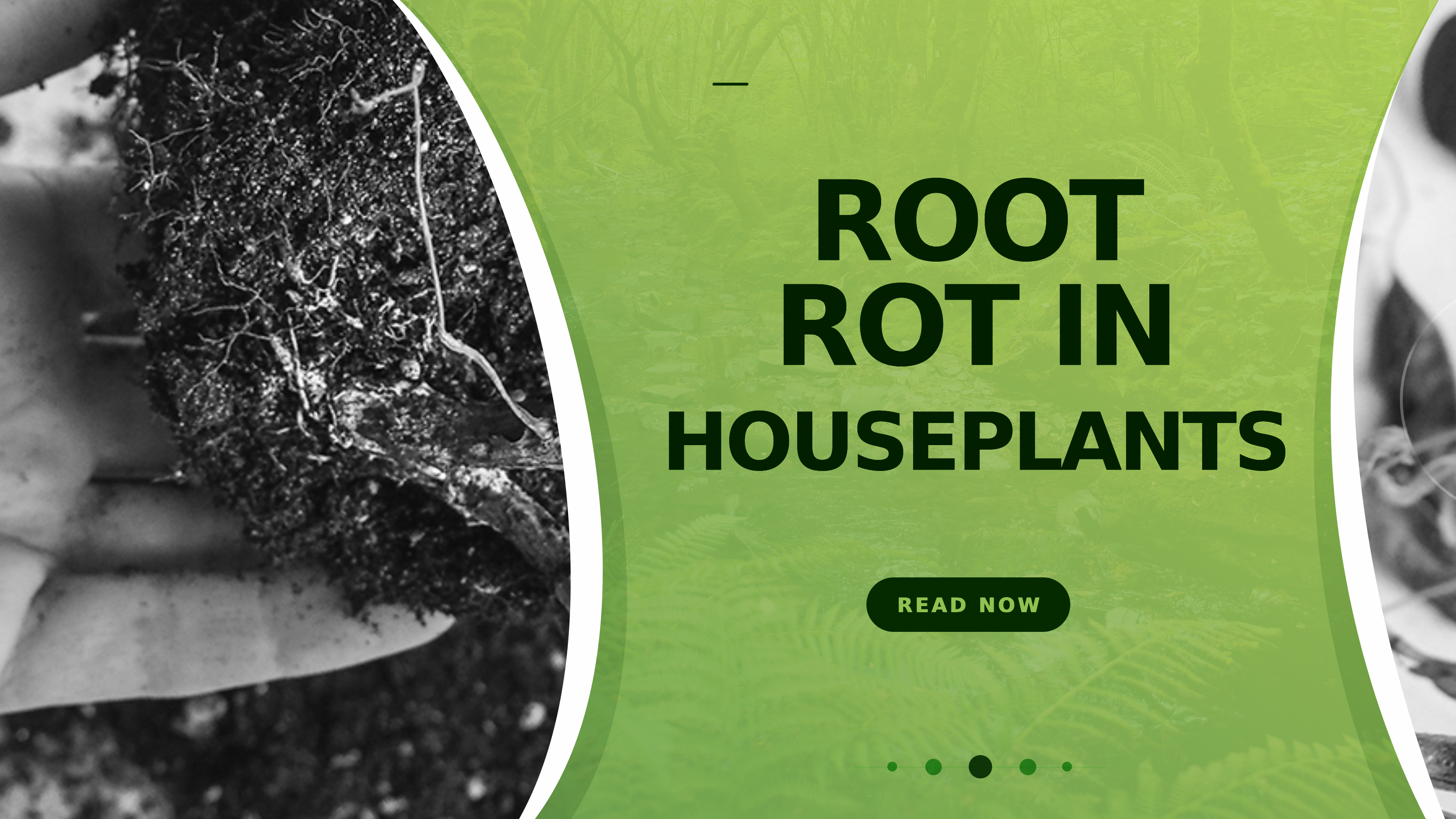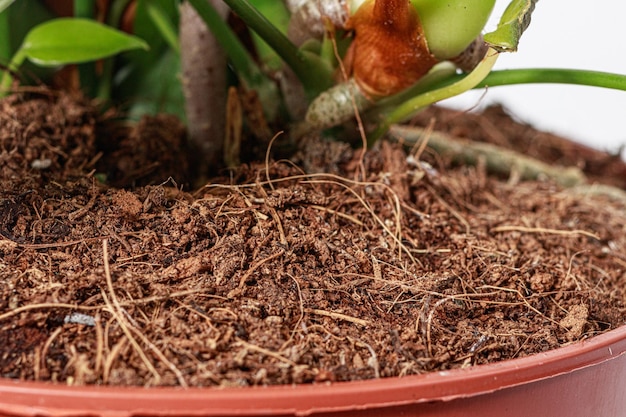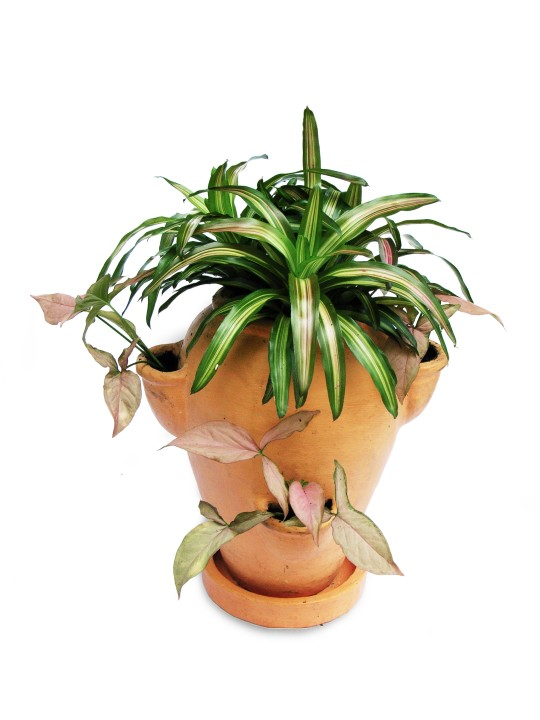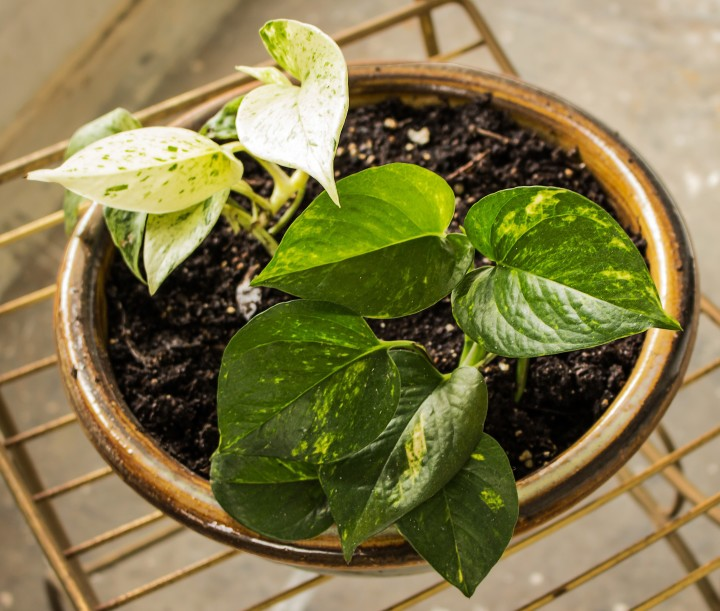HousePlantJoy is supported by our audience. When you purchase through one of our links, we may earn a small affiliate commission. As an Amazon Associate I earn from qualifying purchases. Your cost is not affected.
==================
The heartache of watching your beloved houseplants wilt and wither is a sentiment that resonates with every plant enthusiast. I vividly recall when my cherished plant, the embodiment of vitality and beauty, began to show distressing signs of decline. The culprit behind its demise? Root rot. The anguish of witnessing a once-vibrant companion succumb to this insidious ailment was a wake-up call, urging me to delve into the depths of plant care and unravel the enigma of root rot.
In indoor gardening, root rot lurks as a silent adversary, often leaving gardeners bewildered and disheartened. That initial encounter left me grappling with the immediate loss and the question: Could this have been prevented? The journey to answer that question unearthed a wealth of information and a newfound determination to share my insights to prevent others from facing the same heartache.
As I embarked on a quest to understand the intricacies of root rot, the pieces began to fall into place. I thought the moisture nurturing my plants was the harbinger of their demise. The dampness, once thought to be a sign of care, was, in fact, a breeding ground for root rot. And so, armed with knowledge, I realized that there were measures I could have taken to avert this tragedy.
I am compelled to share my discoveries with fellow plant lovers and budding horticulturists. Through this article, I hope to shed light on the insidious nature of root rot, its causes, its telltale signs, and most importantly, its prevention and treatment. Empowered by this information, you, too, can safeguard your cherished houseplants from the clutches of root rot.
So, whether nurturing a collection of vibrant succulents or tending to a cherished orchid, this article aims to equip you with the tools to cultivate a thriving haven of greenery within your home. Let’s embark on this journey together, unravelling the mysteries of root rot and nurturing our botanical companions toward flourishing vitality.
Recognizing Root Rot in Houseplants
Root Rot in Houseplants and Ways to Prevent It
Image Source: FreeImages
As a houseplant enthusiast, I’ve experienced the joy and satisfaction of watching my plants grow and thrive. However, I’ve also encountered a few challenges along the way, one of which is root rot. This common but often overlooked problem can be disastrous for houseplants if not addressed in time. In this article, I’ll help you recognize what root rot looks like, how to treat it, and most importantly, how to prevent it from happening in the first place. Your indoor plants will thank you!
Introduction to Root Rot in Houseplants
Root rot is a fungal disease that affects a plant’s root system, causing them to decay, turn brown or black, and become mushy. This disease can be caused by a variety of fungi, including Pythium, Rhizoctonia, and Fusarium. Root rot is typically triggered by overwatering or poor drainage, leading to an environment in which fungi can thrive. The excess moisture saturates the soil, depriving the roots of oxygen and allowing the fungi to multiply.
As the roots rot, the plant’s ability to absorb water and nutrients is compromised, leading to a range of symptoms such as yellowing leaves, wilted or stunted growth, and eventually, plant death. Identifying root rot early and taking action can save your beloved houseplants from this unfortunate fate.
Many times, rotting roots go unnoticed until the late stages. At that point, treating root rot and saving the plant becomes much more difficult.
Identifying Root Rot Symptoms and Signs
Recognizing the symptoms and signs of root rot is crucial for early intervention and treatment. Here are some common root rot symptoms to look out for:
- Yellowing leaves: One of the first signs of root rot is leaves turning yellow, often starting with the lower leaves and progressing upwards. This can also be a sign of other issues, so it’s important to examine the roots for further confirmation.
- Wilting: Despite receiving sufficient water, a plant with root rot may appear wilted and droopy. This is because the damaged root system cannot properly absorb water and nutrients.
- Stunted growth: A plant with root rot will often display poor or slow growth, as it struggles to obtain the necessary nutrients for growth.
- Foul smell: As the roots decay, they may produce a foul, musty smell. If you notice an unpleasant odor coming from the soil, it’s time to investigate the roots.
- Root appearance: Healthy roots should be white or light tan and firm to the touch. If the roots appear brown, black, or mushy, this is a clear indication of root rot.
What Does Root Rot Look Like in Different Houseplants
While the general symptoms of root rot are similar across different plants, it’s essential to know what root rot looks like in your specific houseplants, as this can help you identify the problem quickly.
- Pothos: Pothos is a popular houseplant known for its hardiness and easy care. However, it can still fall victim to root rot. Pothos with root rot will exhibit yellowing leaves and a decline in overall health. Its roots will appear brown and mushy, often with a slimy texture.
- Snake plant: Snake plants, also known as Sansevieria, can also develop root rot. Signs include yellowing leaves, soft and mushy leaf bases, and a foul smell coming from the soil. The roots will be brown or black and mushy.
- Philodendron: Philodendron plants with root rot may have yellowing leaves that eventually turn brown and fall off. The roots will be dark brown or black and soft to the touch.
- Spider plant: Spider plants are generally easy to care for, but they can experience root rot as well. Symptoms include yellowing leaves, wilted growth, and a foul odor coming from the soil. The roots will be dark and mushy.
Remember that while these descriptions can help you identify root rot, it’s essential to examine the roots to confirm the issue.
Spider plants can develop root rot
Causes and Contributing Factors of Root Rot
Understanding the causes and contributing factors of root rot can help you prevent it from occurring in your houseplants. The primary cause of root rot is overwatering and poor drainage, leading to excess moisture in the soil. Other factors that can contribute to root rot include:
- Poorly draining soil: Heavy, water-retaining soils can promote root rot by keeping the roots constantly wet.
- Container size: Using a container that is too large for your plant can lead to soil retaining too much moisture, increasing the risk of root rot.
- Lack of aeration: Compacted soil or a lack of air pockets in the soil can lead to oxygen deprivation, promoting fungal growth.
- Contaminated tools: Using contaminated tools or containers can introduce fungi into the soil, increasing the risk of root rot.
How to Treat Root Rot: Effective Root Rot Treatment Methods
If you’ve identified root rot in your houseplants, it’s crucial to act quickly to save them. Here are some effective root rot treatment methods:
- Remove the affected plant from its pot and gently remove the soil from the roots.
- Using a sterilized pair of scissors or pruning shears, trim away any brown, black, or mushy roots. Be sure to sterilize the tool after each cut to prevent spreading the infection.
- After trimming the affected roots, rinse the remaining healthy roots with water to remove any remaining fungi.
- Repot the plant in a clean container with fresh, well-draining soil. You may also want to consider adding a fungicide to the soil to help combat any remaining fungi.
- Water the plant sparingly, allowing the soil to dry out between waterings to prevent further root rot.
Pro Tips:
- Combine one part 3% hydrogen peroxide with two parts water. Pour this over the plant’s roots or use a spray bottle to spray it on. I sometimes dip the roots in a cup containing the diluted hydrogen peroxide. This will kill the fungus and associated bacteria.
- Use a mixture of 5 ml (1 teaspoon) of 3% hydrogen peroxide in 240 ml (one cup) of water to spray on your plants. This works with healthy plants, too, as a means of keeping bacteria and fungus controlled. (full article here)
Discover an effective root rot treatment formula that can breathe new life into your plants, bringing them back to their vibrant best. Say goodbye to root rot woes and hello to a flourishing garden with this recommended solution! #ads #commissionsearned
How to Prevent Root Rot: Root Rot Prevention Tips
Preventing root rot is much easier than treating it, and by following these root rot prevention tips, you can keep your houseplants healthy and thriving:
- Use well-draining soil: Choose a soil mix that drains well and contains ingredients such as perlite or vermiculite to improve aeration.
- Water properly: Overwatering is the leading cause of root rot, so be sure to water your plants according to their specific needs, allowing the soil to dry out between waterings.
- Choose the right container: Select a container with drainage holes and avoid using containers that are too large for your plant.
- Maintain a clean environment: Keep your tools, containers, and workspace clean to avoid introducing fungi to your plants.
- Monitor your plants: Regularly inspect your plants for signs of root rot and address any issues as soon as they arise.
Pro Tips
- Use a mixture of 5 ml (1 teaspoon) of 3% hydrogen peroxide in 240 ml (one cup) of water to spray on your plants. This works with healthy plants, too, as a means of keeping bacteria and fungi controlled. (full article here)
- Check for early signs of rotting roots when you transplant your houseplant to a new pot. The plant roots should look healthy with no signs of fungal infection.
- When watering your plants, note any that still have wet soil from previous waterings. Houseplant soil conditions should show slow drying after a few days. If not, check the roots.
How to Fix Root Rot: Steps for Recovery and Prevention
If you’ve successfully treated root rot in your houseplants, it’s essential to take steps to encourage recovery and prevent future occurrences. Here are some steps for recovery and prevention:
- Provide optimal care: Ensure your plant receives the appropriate amount of light, water, and nutrients to promote healthy growth.
- Be patient: Recovery from root rot can be slow, so be patient and give your plant time to regain its health.
- Monitor your plant: Keep a close eye on your plant for any signs of root rot returning, and address any issues promptly.
- Continue to practice root rot prevention tips: Implement the root rot prevention tips outlined earlier to keep your plant healthy and free from root rot.
Again, we’ve uncovered a game-changing remedy to combat root rot, a formula that promises to rejuvenate your plants and restore them to their former glory. Bid farewell to persistent root rot issues and usher in a garden teeming with life and vibrancy, courtesy of this highly recommended solution! #ads #commissionsearned
Common Mistakes in Root Rot Prevention and Treatment
Despite our best intentions, we can sometimes make mistakes in preventing and treating root rot. Here are some common errors to avoid:
- Overwatering: Be sure to water your plants according to their specific needs, and avoid the urge to water too frequently.
- Ignoring drainage: Ensure your plant’s container has drainage holes and that the soil is well-draining. 3.Using contaminated tools: Always sterilize your tools before and after use to prevent the spread of fungi.
- Neglecting to inspect roots: Regularly inspecting your plant’s roots can help you catch root rot early and prevent it from spreading.
- Using the wrong soil: Using heavy, water-retaining soil can increase the risk of root rot, so be sure to choose a well-draining soil mix.
Is it root rot?
Additional Resources for Dealing with Root Rot
If you’re still struggling with root rot in your houseplants, don’t despair. There are plenty of resources available to help you. Here are a few additional resources for dealing with root rot:
- Online forums and communities: Joining online communities of houseplant enthusiasts can provide you with a wealth of knowledge and support. We recommend:
- HousePlantJoy Growers (Facebook group)
- HousePlantJoy on Facebook
- Professional help: If you’re unsure how to proceed or have a severe case of root rot, consider consulting a Master Gardener at your county Extension office. They offer expert advice at no charge!
Maintaining Healthy Houseplants and Avoiding Root Rot
Root rot is a common problem that can be devastating to your houseplants if left untreated. By recognizing the symptoms and signs of root rot, understanding its causes, and taking steps to prevent and treat it, you can keep your plants healthy and thriving. Remember to use well-draining soil, water your plants appropriately, and monitor them regularly for signs of root rot. With a little bit of care and attention, you can prevent root rot and enjoy healthy, vibrant houseplants for years to come.
Embrace Blooming Success: Nurturing Your Houseplants to Thrive
In the lush world of houseplants, the threat of root rot can cast a shadow on our leafy companions. However, armed with the knowledge of its causes, symptoms, treatment, and prevention, you can don your gardening gloves with confidence. Remember, the key lies in striking a balance – not too much water, well-draining soil, and proper ventilation. By keeping a watchful eye on your plants and nurturing them with care, you’re not just growing greenery; you’re cultivating a thriving ecosystem within the comfort of your home. So, as you embark on this botanical journey, may your plants thrive, and your thumb turn ever greener. Happy gardening!
FAQs
Help! I think my houseplant has root rot. Can I save it?
Don’t panic! While root rot can be a serious issue for houseplants, there are steps you can take to potentially save your green friend. First, remove the plant from its pot and carefully examine the roots. Trim away any mushy or discolored roots with clean, sharp scissors. Next, repot the plant in fresh, well-draining soil. Make sure the new pot has drainage holes to prevent water from pooling at the bottom. Lastly, adjust your watering routine. Let the soil dry out slightly between waterings and ensure you’re not overwatering. With a little care and patience, your houseplant may bounce back!
What are the common signs of root rot in houseplants?
Recognizing the signs of root rot early on can greatly increase your chances of saving your plant. Keep an eye out for wilting leaves that don’t respond to watering, yellowing or browning of leaves, stunted growth, and an unpleasant, musty odor coming from the soil. If you notice any of these symptoms, it’s important to act promptly. Checking the roots is a good next step. Gently remove the plant from its pot and inspect the roots for discoloration, mushiness, or a foul smell. Catching root rot in its early stages gives you a better chance of treating it effectively.
How can I prevent root rot in my houseplants?
Prevention is key when it comes to root rot. Here are some tips to help you keep your houseplants healthy and free from this common issue. First and foremost, ensure that your plants are potted in well-draining soil and containers with drainage holes. This allows excess water to escape and prevents water from stagnating around the roots. Be mindful of your watering habits and avoid overwatering. Before watering, check the moisture level of the soil by sticking your finger about an inch deep into the soil. If it feels dry, it’s time to water. Additionally, avoid using saucers or decorative outer pots that can trap excess water. Finally, provide adequate light and ventilation for your plants, as poor air circulation can contribute to root rot.
Explore Houseplant Joy: Your Green Haven!
Join our vibrant community passionate about plant disease treatment, prevention, and houseplant home design. Discover engaging content, product reviews, and connect with fellow enthusiasts on our social media accounts:
Facebook: Unleash your love for houseplants, explore captivating content, and unravel secrets of plant care!
Instagram: Step into an oasis of inspiration with mesmerizing photos and practical tips.
Pinterest: Infuse your home with natural beauty through beautiful images and DIY projects.
Twitter: Stay up to date with trends, engaging discussions, and find helpful product reviews.
Embark on a botanical adventure with Houseplant Joy! Follow us on Facebook, Instagram, Pinterest, and Twitter to cultivate inspiration and watch your plant paradise flourish!







